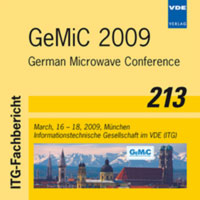Enhanced Parameter Determination of an Empirical UWB Channel Model for European Building Standards
Conference: GeMiC 2009 - German Microwave Conference
03/16/2009 - 03/18/2009 at München, Germany
Proceedings: GeMiC 2009
Pages: 4Language: englishTyp: PDF
Personal VDE Members are entitled to a 10% discount on this title
Authors:
Ott, Arndt T.; Eibert, Thomas F. (Lehrstuhl für Hochfrequenztechnik, Technische Universität München, 80290 München)
Blech, Marcel D. (Institut für Hochfrequenztechnik, Universität Stuttgart, 70550 Stuttgart, Germany)
Kraemer, Michael (LAAS-CNRS, University of Toulouse, 7 Avenue de Colonel Roche, 31077 Toulouse, France)
Abstract:
This paper presents ultra-wideband (UWB) indoor propagation channel measurement techniques and results for the parameters of an empirical channel model. To analyze the channel impulse response an improved technique is applied to remove the parasitic effects of the employed hardware properly. The transmission between the ports of a transmit (TX) and receive antenna (RX) is measured with a vector network analyzer (VNA). As the impulse responses of the antennas are deconvolved from the measurements, the channel transfer function in the frequency range of 2-8 GHz can be determined. This approach is applicable as omnidirectional antennas with almost angularly independent impulse responses are used. A statistical model is employed, based on a large database measured in a commercial indoor environment. The measurements include line-of-sight (LOS) and non-line-of-sight (NLOS) scenarios, where the distance between the transmitter and receiver is varied from 1-5.5 m. To characterize small-scale and large-scale statistics of the channel, at each receiver position 25 measurements are accomplished over a grid with 5x5 spatial points.


